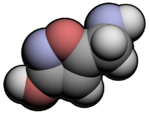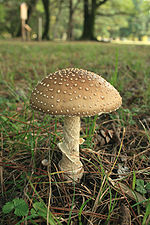- Muscimol
-
Muscimol 
 5-(aminomethyl)- isoxazol-3-ol
5-(aminomethyl)- isoxazol-3-olIdentifiers CAS number 18174-72-6 
PubChem 4266 ChemSpider 4116 
ChEMBL CHEMBL273481 
Jmol-3D images Image 1 - O=C1/C=C(\ON1)CN
Properties[1] Molecular formula C4H6N2O2 Molar mass 114.1 g mol−1 Melting point 184-185 °C, 457-458 K, 363-365 °F
Solubility in water very soluble Solubility in ethanol slightly soluble Solubility in methanol very soluble  (verify) (what is:
(verify) (what is:  /
/ ?)
?)
Except where noted otherwise, data are given for materials in their standard state (at 25 °C, 100 kPa)Infobox references Muscimol (agarin, pantherine) is the major psychoactive alkaloid present in many mushrooms of the Amanita genus. Unlike psilocin (the active metabolite of psilocybin, found in psilocybin mushrooms), which is a serotonergic psychedelic and agonist for the 5-HT2A receptor set, muscimol is a potent, selective agonist for the GABAA receptor set and is a deliriant-like dissociative as a opposed to a classical psychedelic (see hallucinogens).
Contents
Chemistry
Amanita muscaria contains two main active ingredients, ibotenic acid and its derivative muscimol. Muscimol is the product of the decarboxylation or drying of ibotenic acid and it is thought that muscimol is as much as ten times as potent as ibotenic acid.[clarification needed]
Biology
Muscimol is produced naturally in the mushrooms Amanita muscaria, Amanita pantherina, and Amanita gemmata, along with muscarine, muscazone, and ibotenic acid.[2][3] A. muscaria and A. pantherina are not considered safe for human consumption; poisonings have occurred from A. muscaria and A. pantherina as well.[4] In A. muscaria, the layer just below the skin of the cap contains the highest amount of muscimol, and is therefore the most psychoactive portion.[5]
 Amanita muscaria, which contains muscimol
Amanita muscaria, which contains muscimol
Pharmacology
Muscimol is a potent GABAA agonist, activating the receptor for the brain's major inhibitory neurotransmitter, GABA. Muscimol actually binds to the same site on the GABAA receptor complex as GABA itself, as opposed to other GABAergic drugs such as barbiturates and benzodiazepines which bind to separate regulatory sites.[6] GABAA receptors are widely distributed in the brain, and so when muscimol is administered, it alters neuronal activity in multiple regions including the cerebral cortex, hippocampus, and cerebellum.
While muscimol is conventionally thought of as a selective GABAA agonist, it is also a potent partial agonist at the GABAC receptor, and so its range of effects results from a combined action at both targets.[7]
In patients with Huntington's disease and chronic schizophrenia, oral doses of muscimol have been found to cause a rise of both prolactin and growth hormone.[8]
During a test involving rabbits connected to an EEG, muscimol showed a distinctly synchronized EEG tracing. This is substantially different from indolic psychedelics, as brainwave patterns will generally show a desynchronization. In higher doses (2 mg/kg), the EEG will show characteristic spikes.[citation needed]
If consumed, muscimol will pass through the human body, and be excreted unchanged in the subject's urine.
The psychoactive dose of muscimol is around 10–15 mg for a normal person.[9][unreliable source?] A Guide to British Psilocybin Mushrooms by Richard Cooper published in 1977 recommends a smaller dose, 8.5 mg, and suggests that it is possible for this amount to be present in as little as 1 g of dried A. muscaria. A correct dose may be difficult to determine because potency varies dramatically from one mushroom to the next.
Toxicity
The LD50 in mice is 3.8 mg/kg s.c, 2.5 mg/kg i.p.[10] The LD50 rats is 4.5 mg/kg i.v, 45 mg/kg orally.[10]
Effects
The effects of muscimol are substantially different from Psilocybe mushroom alkaloids, as the chemicals target separate parts of the brain. Muscimol has been shown to lack "structured" hallucinations in most cases, and the effects are frequently compared to a lucid dream state. The hallucinogenic effect produced by muscimol is most closely comparable to the hallucinogenic side effects produced by some other GABAergic drugs such as zolpidem.[1]
See also
References
- ^ The Merck Index, 12th Edition
- ^ Chilton, WS; Ott, J (1976). "Toxic metabolites of Amanita pantherina, A. Cothurnata, A. Muscaria and other Amanita species". Lloydia 39 (2-3): 150–7. PMID 985999.
- ^ Michelot, D; Melendez-Howell, LM (2003). "Amanita muscaria: chemistry, biology, toxicology, and ethnomycology". Mycological Research 107 (Pt 2): 131–46. doi:10.1017/S0953756203007305. PMID 12747324.
- ^ Tupalska-Wilczyńska, K; Ignatowicz, R; Poziemski, A; Wójcik, H; Wilczyński, G (1996). "Poisoning with spotted and red mushrooms--pathogenesis, symptoms, treatment". Wiadomosci lekarskie (Warsaw, Poland : 1960) 49 (1-6): 66–71. PMID 9173659.
- ^ Chilton W.S. Chemistry and Mode of Action of Mushroom Toxins. Mushroom Poisoning: Diagnosis and Treatment. —Ed.: B.H. Kumach, E. Salzman, Palm Beach: CRC Press. Inc., 1978. —P. 87-124.
- ^ Frølund, B; Ebert, B; Kristiansen, U; Liljefors, T; Krogsgaard-Larsen, P (2002). "GABA(A) receptor ligands and their therapeutic potentials". Current Topics in Medicinal Chemistry 2 (8): 817–32. doi:10.2174/1568026023393525. PMID 12171573.
- ^ Woodward, RM; Polenzani, L; Miledi, R (1993). "Characterization of bicuculline/baclofen-insensitive (rho-like) gamma-aminobutyric acid receptors expressed in Xenopus oocytes. II. Pharmacology of gamma-aminobutyric acidA and gamma-aminobutyric acidB receptor agonists and antagonists". Molecular pharmacology 43 (4): 609–25. PMID 8386310.
- ^ Tamminga, CA; Neophytides, A; Chase, TN; Frohman, LA (1978). "Stimulation of prolactin and growth hormone secretion by muscimol, a gamma-aminobutyric acid agonist.". The Journal of clinical endocrinology and metabolism 47 (6): 1348–51. doi:10.1210/jcem-47-6-1348. PMID 162520.
- ^ Erowid Psychoactive Amanitas Vault : Dosage
- ^ a b Erowid Psychoactive Amanitas Vault : Chemistry
- Ito Y, Segawa K, Fukuda H (1995). "Functional diversity of GABAA receptor ligand-gated chloride channels in rat synaptoneurosomes". Synapse 19 (3): 188–96. doi:10.1002/syn.890190306. PMID 7784959.
- Rätsch, Christian. (1998). The Encyclopedia of Psychoactive Plants. Rochester, VT: Park Street Press.
- Beaumont K, Chilton W. S., Yamamura H. I., Enna S. J. (1978). "Muscimol binding in rat brain: association with synaptic GABA receptors". Brain Res. 148 (1): 153–62. doi:10.1016/0006-8993(78)90385-2. PMID 207386.
- S. R. Snodgrass (1978). "Use of 3H-muscimol for GABA receptor studies". Nature 273 (1): 392–394. doi:10.1038/273392a0.
- G. A. R. Johnston, D. R. Curtis, W. C. de Groat and A. W. Duggan (1968). "Central actions of ibotenic acid and muscimol". Biochemical Pharmacology 17 (12): 2488–2489. doi:10.1016/0006-2952(68)90141-X. PMID 5752907.
- Tamminga CA, Neophytides A, Chase TN, Frohman LA (December 1978). "Stimulation of prolactin and growth hormone secretion by muscimol, a gamma-aminobutyric acid agonist". J. Clin. Endocrinol. Metab. 47 (6): 1348–51. doi:10.1210/jcem-47-6-1348. PMID 162520.
External links
A. albocreata - A. crenulata
- A. farinosa
- A. frostiana
- A. gemmata
- A. multisquamosa
- A. muscaria
- A. pantherina
- A. porphyria
- A. regalis
- A. strobiliformis
- A. xanthocephala
Compounds- Toxins: Ibotenic Acid
- Muscimol
- Other compounds: Muscarine
- Muscazone
- Amavadine

Destroying angels - A. bisporigera
- A. exitialis
- A. magnivelaris
- A. ocreata
- A. verna
- A. virosa
- A. virosiformis
Other members- A. arocheae
- A. phalloides
- A. subjunquilea
Compounds- Phallacidin
- Phallacin
- Phallisacin
- Phallisin
- Phalloidin
- Phalloin
- Prophalloin
Other compounds- Antamanide
- Phallolysin
- Toxophallin
A. abrupta - A. nauseosa
- A. proxima
- A. smithiana
- A. sphaerobulbosa
- A. thiersii
Compounds- Allenic norleucine (2-amino-4,5-hexadienoic acid)
- Propargylglycine
A. rubescens (A. amerirubescens nom. prov.) Compounds- Rubescenslysin
GABAergics Receptor
ligandsReuptake
inhibitorsPlasmalemmalGAT inhibitorsCI-966 • Deramciclane • EF-1502 • Gabaculine • Guvacine • Nipecotic acid • NNC 05-2090 • SKF-89976A • SNAP-5114 • TiagabineEnzyme
inhibitorsGAD inhibitorsAllylglycineGABA-T inhibitors3-Hydrazinopropionic acid • Aminooxyacetic acid • Gabaculine • Isoniazid • Phenelzine • Phenylethylidenehydrazine • Sodium valproate • Valnoctamide • Valproate pivoxil • Valproate semisodium (Divalproex sodium) • Valproic acid • Valpromide • VigabatrinOthers Glutamate • GlutamineOthersCategories:- Entheogens
- Mycotoxins
- Isoxazoles
Wikimedia Foundation. 2010.
